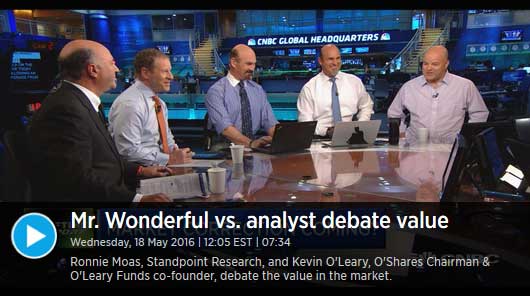Standpoint Research issues 50-75 stock recommendations annually (from all eleven sectors) and has been doing so since 2004. Ideas are generated by a 155-variable computer model that took (Ronnie Moas) five years to develop (1998-2003). Click here to see a sample (output) of what the computer model generates when we run a list of names through there.
Once an idea is generated, heavy fundamental and subjective overlays are applied before going out with an actual recommendation. Click here to see a sample report (45 pages).
It is important to note the difference between ideas generated by the computer model that Ronnie developed and actual recommendations he issues. Standpoint Research does not like all names that rank high according to the computer model – and does not dislike all low-ranking names either.
The 155 variables are divided up into 32 categories. A color-coded profile is then generated showing how each stock scored on an absolute and relative basis in each of these categories. The 32 categories are then broken down and ranked on fundamentals, valuation, technicals, proprietary, accounting and miscellaneous measures. A weighted total score is then calculated and you can see that on the far right side (column) in the Excel spreadsheet (click link above).
Fundamentals and valuation get the heaviest weighting. Relative strength and technical indicators, when at extreme levels, are to a certain extent weighted negatively. For long recommendations, we look for out-of-favor stocks that are scoring well on the majority of the variables we weigh. We will rarely recommend stocks that are trading near their respective highs, but will do so from time-to-time if the relative and absolute valuation is attractive. These recommendations do not occur often, because the model ‘understands’ that at those price levels the stocks are usually priced for perfection; the risk/reward ratio is no longer favorable; and the upside may be limited. Of course, these highs must be combined with other indicators in order to trigger an acceptance or rejection.
The model looks for combinations of variables that have been back-tested and proven to result in out-performance. We look for out-of-favor stocks with an upside that is double (or triple) what we feel is the remaining downside risk. There are elements of mean reversion embedded in the model as well as scale-trading techniques used in commodities. Good stocks, just like commodities, usually have a floor price; a price that is so low that any supply hitting the market will be purchased (at that price).
The model looks more at relative ratios than absolute ratios. If, for example, a sector, industry or name is trading at a multiple that is 1.2X their historical average, it is unlikely a recommendation will be generated. If it is trading at 0.8X, it will be more likely to catch our attention.
If a company is trading at 20X earnings, but our research shows that they have been consistently writing off expenses as one-time charges, they are in effect artificially deflating their P/E/G ratio. If we see a company writing off 25% of their expenses as one-time charges, it does not go ignored. If this company has a market cap of $6,000,000,000 with $300,000,000 in earnings that excludes a $100,000,000 charge, we value this company as though they are trading at 30X earnings (of $200 mln) and not 20X.
Note: This is a complex model that took many years to develop and back-test. It runs off 155 variables and dozens of calculations. This is merely a brief summary and only scratches the surface regarding the methodology and product description while protecting the proprietary nature of what we do. Feel free to contact us if you have additional questions.



